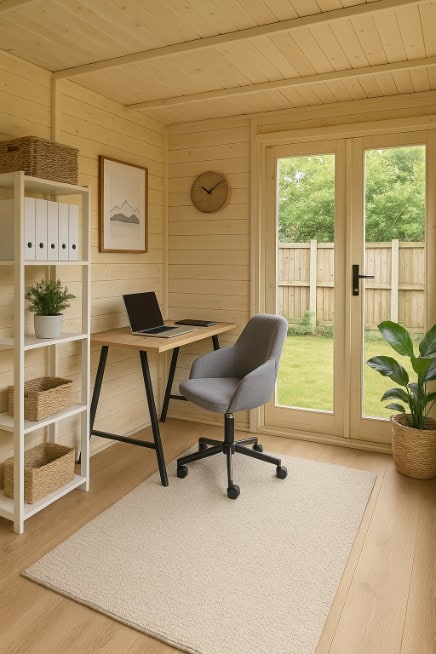Jump to:
Summerhouse garden office setups might look the part, but not every summer house is built for the job. Most are made for sitting out and relaxing, and not for full-time work, but the idea is there.
If you’re in the market for a summerhouse or you’re thinking about updating your existing one, you might be able to make use of it for office purposes, as long as it has the right features. This guide covers what you need to know by answering a few of the frequently asked questions.
Can a Summerhouse Be Used as a Garden Office?

Yes, it’s possible, but it comes with some considerations, as it might not meet the demands of a proper office setup.
You’ll likely need to upgrade the space, especially when it comes to insulation and/or heating. These extras are crucial to keep the space warm during winter and ensure it doesn’t become too hot in the summer.
Most standard models have unlined walls, meaning they don’t come insulated, which is fine for casual use in warm weather. But it’s something to sort out if you plan to work there regularly.
Electrical work is another consideration for lighting, your desktop setup, and other equipment. Unless your summer house already has all these, you can furnish the space and install the office WiFi. Electrical work must comply with Part P of the UK Building Regulations, so it’s best to use a qualified electrician for safety and compliance.
Not to mention, the large windows might also be too much for your liking. They can get in the way if you want that sense of privacy, or you’re struggling with screen glare. Adding blinds or curtains, or even a reflective film, can help make it better suited for work.
What Is a Summerhouse Best Suited For?
Summer houses are garden rooms built for relaxation and entertainment. A place to sit, read, have a cuppa, or enjoy the view in spring and summer. These summerhouse seating ideas are packed with inspiration if you need more.
Overall, they’re designed more for comfort and light use than year-round work. But many do use them for casual work when the weather is good.
Say you’re mostly at your kitchen table but fancy a change of scene on a sunny day. Moving your laptop to the summerhouse for a few hours can be a nice break. You can get on with anything that doesn’t need a full workspace.
What Do You Need to Make a Summerhouse Garden Office Work?
We’ve already touched on most of these points, but let’s go into more detail:
Insulation and heating
Insulate the walls, ceiling, and floor. Rigid foam boards and insulation batts are great options for this. You can do this yourself, but if you’re not equipped or don’t have the experience, call in the pros.
Insulating the walls works by trapping heat inside and blocking the cold from seeping in. Ceiling insulation helps stop warm air from rising and escaping. Meanwhile, insulated floors provide a solid barrier against heat loss.
Read our guide to ‘How to Insulate a Garden Office’ to learn more.
Heating can be optional, but it’s a worthwhile investment if you live in a colder region. A portable electric heater or oil-filled radiator will suffice for smaller spaces. They’re easy to use and move around—and ideal if you don’t need constant heat.
A wall-mounted electric heater is perfect if you prefer a more permanent solution. It warms up the room quickly and tends to be more energy-efficient.
Electricity and lighting
Electricity = outlets. Think about where your desk, laptop, and other equipment will be placed. You’ll want an outlet nearby for your computer and possibly another for a printer or lamps. If you have a larger setup, adding extra power points will reduce the need for extension cords.
For lighting, use a combination of overhead and task lighting to keep the space well-lit. Go for LED bulbs, which are energy-efficient and emit clear, bright light. This helps avoid eye strain when working for long hours. Working in the evening? Add a warm light source to avoid harsh lighting affecting your focus.
Office furniture
Start with the basics: a sturdy desk, a comfortable chair, and adequate storage. These should fit even if you have a small summer house.
Invest in a spacious desk for your monitors or laptop, paperwork, and other items. An ergonomic chair is best, especially if you’re going to be sitting for long periods. Add a few shelves or a filing cabinet for storage.
You might want to add a few personal touches, like some plants or a comfy sofa for breaks, if space allows. The goal is to make it feel your own, so you can stay comfortable and focused while working.
Can You Legally Run a Business from a Summerhouse?
Yes, you can. But if the summerhouse is used exclusively for business, it could be classed as a non-domestic structure. In this case, you may need to pay business rates, although small business relief often applies.
If the space is used for both home and work (dual-use), you might still avoid business rates.
Do you need planning permission?
If the use of your summerhouse becomes commercial in nature, your local planning authority may require you to apply for permission. You are more likely to need it if:
- You are running a registered business
- Clients, employees, or deliveries regularly come and go.
- The building is used for full-time, profit-making operations.
- It causes a noticeable change to the use of your property (e.g. increased footfall or noise).
Occasional remote work or admin duties usually don’t require planning permission, but running a business full-time from a summerhouse might.
What You Should Do
Speak to your local council: Every authority may assess usage differently, especially if there are complaints or visible business activity.
Review your mortgage and home insurance: Some lenders or policies may restrict commercial use of residential property.
Avoid nuisance: Ensure your setup doesn’t disturb neighbours with noise, increased traffic, or signage.
Would You Work from Home Better in a Garden Office? As a next step, take a quiz to see if a summerhouse garden office suits you!





